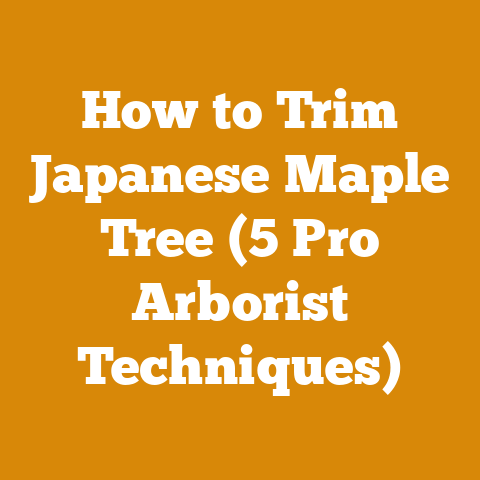White Specks on Wood Explained (5 Expert Signs You Should Know)
I’ve always been fascinated by wood. From the rich grain of a freshly felled oak to the comforting crackle of a seasoned log in the fireplace, it’s a material that speaks to history, nature, and craftsmanship. But sometimes, wood throws us a curveball. Those pesky white specks that appear on its surface can be a real head-scratcher, and potentially a headache for your wallet.
In this article, I will delve into the common reasons behind these white specks, offering expert insights, and, importantly, discussing the costs associated with each potential issue and its solution. We’ll cover everything from mold and mildew to mineral deposits and even insect infestations, equipping you with the knowledge to diagnose the problem and take appropriate action.
1. Mold and Mildew: The Fungal Foe
Mold and mildew are perhaps the most common culprits behind white specks on wood, especially in damp or poorly ventilated environments. These fungi thrive on moisture and organic matter, and wood provides the perfect breeding ground.
Identifying Mold and Mildew:
- Appearance: Mold and mildew often appear as fuzzy or powdery white, gray, or even greenish spots. They can also have a musty odor.
- Location: Look for them in areas with high humidity, such as basements, bathrooms, or poorly ventilated storage spaces.
- Texture: The specks might feel slightly raised or textured to the touch.
Costs Associated with Mold and Mildew:
This is where things can get tricky, and the costs can vary dramatically.
-
DIY Cleaning: For small, localized areas of mold or mildew, you can often tackle the problem yourself. This typically involves:
- Cleaning Supplies: Mold and mildew cleaner (typically $10-$20 per bottle), gloves, masks, scrub brushes. Let’s estimate $30 for a basic DIY cleaning kit.
- Labor: Your time! This can range from a few hours for a small area to a full day for a larger infestation. Consider your time as a cost, even if you’re not paying someone else. Time is money, as they say.
-
Professional Mold Remediation: If the mold infestation is extensive, or if you suspect it’s a more serious type of mold (like black mold), professional remediation is essential. This is where costs can skyrocket.
- Inspection: A professional mold inspection can cost anywhere from $200 to $800, depending on the size and complexity of the area.
- Remediation: Mold remediation costs can range from $500 to tens of thousands of dollars, depending on the severity of the infestation, the size of the affected area, and the materials that need to be removed and replaced. I’ve seen cases where homeowners have spent over $10,000 to fully remediate mold in their homes.
- Example: Let’s say you have a mold problem in a 100-square-foot basement. Professional remediation might involve:
- Containment of the area.
- Removal of affected drywall and insulation.
- Cleaning and disinfecting the remaining surfaces.
- Application of a mold-resistant coating.
- Replacing the drywall and insulation.
- This could easily cost between $2,000 and $5,000.
Preventing Mold and Mildew (and Saving Money):
- Ventilation: Ensure good ventilation in damp areas. Use exhaust fans in bathrooms and kitchens.
- Dehumidifiers: Use dehumidifiers in basements and other areas prone to high humidity. A good dehumidifier can cost between $150 and $300, but it’s a worthwhile investment to prevent mold growth.
- Proper Storage: Store firewood properly, off the ground and covered, to prevent moisture buildup. I always stack my firewood with plenty of air circulation to promote drying.
- Promptly Address Leaks: Repair any leaks in your roof, plumbing, or foundation immediately. Even a small leak can create a breeding ground for mold.
Personal Experience: I once had a small mold problem in my shed where I store firewood. I caught it early and was able to clean it up myself with a mold and mildew cleaner. The total cost was probably around $20, but the peace of mind was priceless. If I had ignored it, it could have spread and caused significant damage to the shed and the firewood.
2. Mineral Deposits: The Water’s Legacy
Another common cause of white specks on wood is mineral deposits left behind by water. This is especially common in areas with hard water, which contains high levels of calcium and magnesium.
Identifying Mineral Deposits:
- Appearance: Mineral deposits typically appear as hard, chalky white spots or streaks.
- Location: Look for them on surfaces that are frequently exposed to water, such as near sinks, showers, or areas where water might splash.
- Texture: The specks will feel hard and gritty to the touch.
Costs Associated with Mineral Deposits:
Fortunately, mineral deposits are usually easier and less expensive to deal with than mold or mildew.
-
DIY Cleaning: You can often remove mineral deposits with household cleaning products.
- Cleaning Supplies: White vinegar, lemon juice, or commercial limescale remover (typically $5-$15 per bottle), scrub brushes, cloths. Let’s estimate $20 for a basic cleaning kit.
- Labor: Again, your time is a factor. Depending on the size and severity of the deposits, it could take a few hours to clean them up.
-
Water Softener: If you have hard water, installing a water softener can prevent mineral deposits from forming in the first place.
- Water Softener System: A water softener system can cost between $500 and $2,000, depending on the size and features.
- Installation: Professional installation can cost an additional $200 to $500.
- Salt: You’ll also need to factor in the cost of salt for the water softener, which can range from $10 to $20 per bag.
Preventing Mineral Deposits (and Saving Money):
- Wipe Up Spills: Wipe up water spills promptly to prevent mineral deposits from forming.
- Use Filtered Water: Use filtered water for cleaning and washing surfaces that are prone to mineral deposits.
- Apply Protective Coatings: Apply a protective coating, such as a sealant or varnish, to wood surfaces to prevent water from penetrating.
Personal Experience: I live in an area with notoriously hard water. I’ve found that regularly wiping down surfaces with a solution of white vinegar and water helps to prevent mineral deposits from building up. It’s a simple and inexpensive solution that saves me a lot of time and effort in the long run.
3. Efflorescence: The Concrete Connection
Efflorescence is a white, powdery deposit that can appear on concrete or masonry surfaces. It’s caused by water dissolving soluble salts within the concrete and then evaporating, leaving the salts behind on the surface. While efflorescence is not directly a wood problem, it can transfer to wood if the wood is in contact with affected concrete.
Identifying Efflorescence:
- Appearance: Efflorescence appears as a white, powdery or crystalline deposit on the surface of concrete or masonry.
- Location: Look for it on basement walls, foundations, or concrete floors that are in contact with soil.
- Texture: The deposit will feel dry and powdery to the touch.
Costs Associated with Efflorescence:
The cost of dealing with efflorescence depends on the severity of the problem and the extent of the affected area.
-
DIY Cleaning: You can often remove efflorescence with a stiff brush and a solution of water and vinegar or a commercial efflorescence cleaner.
- Cleaning Supplies: Stiff brush, water, vinegar, or commercial efflorescence cleaner (typically $10-$20 per bottle), gloves, mask. Let’s estimate $30 for a basic cleaning kit.
- Labor: Your time! This can range from a few hours for a small area to a full day for a larger area.
-
Sealing the Concrete: To prevent efflorescence from recurring, you can seal the concrete with a waterproof sealant.
- Concrete Sealer: A good quality concrete sealer can cost between $50 and $100 per gallon.
- Application: You can apply the sealer yourself with a brush or roller, or you can hire a professional to do it. Professional application can cost an additional $1 to $3 per square foot.
-
Addressing the Source of Moisture: The most important step in dealing with efflorescence is to address the source of moisture that is causing the problem. This may involve:
- Improving Drainage: Improving drainage around the foundation of your home.
- Repairing Cracks: Repairing cracks in the concrete.
- Installing a Vapor Barrier: Installing a vapor barrier to prevent moisture from seeping through the concrete.
- These repairs can range in cost from a few hundred dollars to several thousand dollars, depending on the severity of the problem.
Preventing Efflorescence (and Saving Money):
- Proper Drainage: Ensure proper drainage around the foundation of your home.
- Waterproof Sealant: Apply a waterproof sealant to concrete surfaces that are in contact with soil.
- Vapor Barrier: Install a vapor barrier to prevent moisture from seeping through the concrete.
Personal Experience: I once had a problem with efflorescence on the concrete floor of my basement. I cleaned it up myself with a stiff brush and a solution of water and vinegar. Then, I sealed the floor with a waterproof concrete sealer. The problem hasn’t recurred since. The total cost was probably around $100, but it saved me from having to deal with the efflorescence again and again.
4. Insect Infestation: The Wood-Boring Bugs
Certain insects, such as powderpost beetles and termites, can infest wood and leave behind white or light-colored dust or frass (insect droppings). This is a serious issue that can compromise the structural integrity of the wood.
Identifying Insect Infestation:
- Appearance: Look for small holes in the wood, along with piles of fine, powdery dust or frass. The dust may be white, cream-colored, or light brown.
- Location: Check for infestations in areas where wood is exposed, such as furniture, flooring, or structural timbers.
- Sound: You may hear a faint clicking or chewing sound coming from the wood.
Costs Associated with Insect Infestation:
Insect infestations can be very expensive to treat, especially if the infestation is widespread.
- Inspection: A professional pest inspection can cost between $100 and $300.
- Treatment: The cost of treatment depends on the type of insect, the severity of the infestation, and the size of the affected area.
- Localized Treatment: For localized infestations, you may be able to treat the wood yourself with a borate-based insecticide. This can cost between $20 and $50 per bottle.
- Fumigation: For widespread infestations, fumigation may be necessary. Fumigation can cost several thousand dollars.
- Replacement: In some cases, the affected wood may need to be replaced. This can be very expensive, especially if it involves structural timbers.
Preventing Insect Infestation (and Saving Money):
- Use Treated Wood: Use treated wood for construction and furniture making.
- Regular Inspections: Inspect wood regularly for signs of infestation.
- Proper Storage: Store firewood properly, off the ground and covered, to prevent insect infestations.
- Remove Dead Wood: Remove any dead or decaying wood from your property.
Personal Experience: I once had a close call with a termite infestation in my garage. I noticed a small pile of sawdust near a wooden support beam. I called a pest control company immediately, and they confirmed that I had a termite infestation. Fortunately, the infestation was caught early, and they were able to treat it with a localized insecticide treatment. The total cost was around $500, but it could have been much worse if I had ignored the problem.
5. Paint or Finish Imperfections: The Coating Culprit
Sometimes, white specks on wood are simply due to imperfections in the paint or finish. This can be caused by:
- Poor Surface Preparation: If the wood surface was not properly prepared before painting or finishing, the paint or finish may not adhere properly, leading to white specks.
- Improper Application: If the paint or finish was not applied correctly, it may result in an uneven coating with white specks.
- Low-Quality Products: Using low-quality paint or finish can also lead to imperfections.
Identifying Paint or Finish Imperfections:
- Appearance: The white specks will appear as small, raised bumps or spots on the surface of the paint or finish.
- Location: Look for them on surfaces that have been recently painted or finished.
- Texture: The specks will feel smooth or slightly rough to the touch.
Costs Associated with Paint or Finish Imperfections:
The cost of fixing paint or finish imperfections depends on the severity of the problem and the size of the affected area.
-
DIY Repair: For small, localized imperfections, you may be able to repair them yourself.
- Supplies: Sandpaper, primer, paint or finish (typically $10-$30 per can or quart), brushes, rollers. Let’s estimate $50 for a basic repair kit.
- Labor: Again, your time is a factor. Depending on the size and severity of the imperfections, it could take a few hours to repair them.
-
Professional Repainting or Refinishing: For larger or more complex imperfections, you may need to hire a professional to repaint or refinish the wood.
- Repainting: The cost of repainting can range from $2 to $5 per square foot.
- Refinishing: The cost of refinishing can range from $3 to $8 per square foot.
Preventing Paint or Finish Imperfections (and Saving Money):
- Proper Surface Preparation: Prepare the wood surface properly before painting or finishing. This includes sanding, cleaning, and priming the surface.
- Proper Application: Apply the paint or finish correctly, following the manufacturer’s instructions.
- High-Quality Products: Use high-quality paint or finish.
Personal Experience: I once tried to save money by using a cheap paint on a wooden fence. The paint started to peel and crack within a few months, and it looked terrible. I ended up having to repaint the entire fence with a high-quality paint, which cost me more in the long run. The lesson I learned is that it’s always better to invest in high-quality products from the start.
Budgeting for Wood Issues: A Practical Guide
Now that we’ve explored the common causes of white specks on wood and the associated costs, let’s talk about budgeting for these potential issues.
1. Risk Assessment:
- Identify Potential Risks: Start by identifying the potential risks that could lead to white specks on your wood. This includes factors such as:
- Location: Is your wood located in a damp or humid environment?
- Wood Type: Is your wood susceptible to insect infestations or mold growth?
- Maintenance: Are you properly maintaining your wood?
- Assess the Likelihood and Impact: For each risk, assess the likelihood of it occurring and the potential impact on your budget.
2. Cost Estimation:
- Research Costs: Research the costs associated with each potential issue. This includes:
- DIY Supplies: The cost of cleaning supplies, sealants, and insecticides.
- Professional Services: The cost of inspections, remediation, and repairs.
- Replacement: The cost of replacing damaged wood.
- Create a Contingency Fund: Set aside a contingency fund to cover unexpected costs. A good rule of thumb is to set aside 10-20% of your total budget for contingencies.
3. Cost Optimization:
- Preventative Measures: Take preventative measures to reduce the likelihood of problems occurring. This includes:
- Proper Ventilation: Ensuring proper ventilation in damp areas.
- Regular Inspections: Inspecting wood regularly for signs of problems.
- Proper Storage: Storing firewood properly.
- DIY vs. Professional: Decide whether you can handle certain tasks yourself or whether you need to hire a professional.
- Shop Around: Get quotes from multiple contractors before hiring someone.
4. Tracking and Monitoring:
- Track Expenses: Keep track of all expenses related to wood maintenance and repairs.
- Monitor Wood: Regularly monitor your wood for signs of problems.
- Adjust Budget: Adjust your budget as needed based on your actual expenses and the condition of your wood.
Case Study: Firewood Preparation Budget
Let’s consider a case study of someone preparing firewood for the winter. Here’s a sample budget:
| Item | Cost | Notes |
|---|---|---|
| Wood Purchase (2 cords) | $400-$800 | Price varies depending on wood type and location. I’ve paid as little as $200/cord for softwood and as much as $400/cord for hardwood. |
| Chainsaw Maintenance | $50-$100 | Sharpening, oil, fuel. I always keep extra chains on hand, which adds to the cost. |
| Splitting Maul/Axe | $50-$100 | Initial purchase if you don’t already own one. A good quality maul is an investment. |
| Safety Gear | $50-$100 | Gloves, safety glasses, ear protection. Absolutely essential for safety! |
| Storage Cover | $20-$50 | To protect the firewood from rain and snow. A tarp works well. |
| Contingency Fund | $100-$200 | For unexpected expenses, such as a broken tool or the need to purchase additional wood. |
| Total | $670-$1450 | This is a rough estimate. The actual cost may vary depending on your specific circumstances. Remember to factor in your time! |
Key Takeaways:
- Prevention is Key: The best way to save money on wood maintenance is to prevent problems from occurring in the first place.
- Early Detection: Catching problems early can save you a lot of money in the long run.
- DIY Can Save Money: You can save money by handling certain tasks yourself, but be sure to consider your skills and experience before taking on a project.
- Budget Wisely: Create a budget and stick to it as closely as possible.
Actionable Steps:
- Inspect Your Wood: Inspect your wood regularly for signs of white specks or other problems.
- Identify the Cause: If you find white specks, try to identify the cause.
- Take Action: Take appropriate action to address the problem.
- Create a Budget: Create a budget for wood maintenance and repairs.
- Preventative Measures: Take preventative measures to reduce the likelihood of problems occurring.
Conclusion:
White specks on wood can be a sign of various issues, ranging from harmless mineral deposits to serious insect infestations. By understanding the potential causes, identifying the problem early, and taking appropriate action, you can protect your wood and avoid costly repairs. Remember to budget wisely and take preventative measures to minimize your expenses. With a little knowledge and effort, you can keep your wood looking its best for years to come. And remember, a little elbow grease and a proactive approach can save you a bundle in the long run. Happy woodworking (and firewood prepping)!






